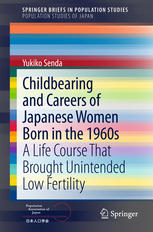

Most ebook files are in PDF format, so you can easily read them using various software such as Foxit Reader or directly on the Google Chrome browser.
Some ebook files are released by publishers in other formats such as .awz, .mobi, .epub, .fb2, etc. You may need to install specific software to read these formats on mobile/PC, such as Calibre.
Please read the tutorial at this link: https://ebookbell.com/faq
We offer FREE conversion to the popular formats you request; however, this may take some time. Therefore, right after payment, please email us, and we will try to provide the service as quickly as possible.
For some exceptional file formats or broken links (if any), please refrain from opening any disputes. Instead, email us first, and we will try to assist within a maximum of 6 hours.
EbookBell Team

5.0
30 reviewsThis book provides the keys to understanding the trajectory that Japanese society has followed toward its lowest-low fertility since the 1980s. The characteristics of the life course of women born in the 1960s, who were the first cohort to enter that trajectory, are explored by using both qualitative and quantitative data analyses. Among the many books explaining the decline in fertility, this book is unique in four ways. First, it describes in detail the reality of factors concerning the fertility decline in Japan. Second, the book uses both qualitative and quantitative methods to introduce the whole picture of how the low-fertility trend began in the 1980s and developed in the 1990s and thereafter. Third, the focus is on a specific birth cohort because their experiences determined the current patterns of family formation such as late marriage and postponed childbirth. Fourth, the book explores the knife-edge balance between work and family conditions, especially with regard to childbearing, in the context of Japanese management and gender norms. After examining the characteristics of demographic and socioeconomic circumstances of postwar Japan in detail, it can be seen that the change in family formation first occurred drastically in the 1960s cohort. Using both qualitative interview data cumulatively from 150 people and quantitative estimates with official statistics, this book shows how individual-level choices to balance work and family obligations resulted in a national-level fertility decline. Another focus of this book is the increasing unintended infertility due to postponed pregnancy, a phenomenon that is attracting great social attention because the average age of pregnancy is approaching the biological limit. This book is a valuable resource for researchers who are interested in the rapid fertility decline as well as the work–life balance and the life course of women in Japanese employment practice and family traditions.